Netherton, Black Country
| Netherton | |
| Worcestershire | |
|---|---|
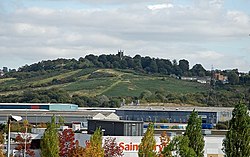 St Andrews, Netherton, and the Merry Hill Shopping Centre | |
| Location | |
| Grid reference: | SO944881 |
| Location: | 52°29’27"N, 2°5’1"W |
| Data | |
| Post town: | Dudley |
| Postcode: | DY2 |
| Dialling code: | 01384 |
| Local Government | |
| Council: | Dudley |
| Parliamentary constituency: |
Dudley South |
Netherton is a town in Worcestershire, within the Black Country, in the detached part of Worcestershire (surrounded by Staffordshire) in which Dudley also sits. Netherton is about a mile and a half south of Dudley.
Despite the growth of neighbouring urban centres in the Black Country in the 20th century, Netherton remains a distinct locality, bordered by nature reserves to the east and west, and an industrial area and the Dudley Southern By-Pass in the north. The southern border is formed by the Mousesweet Brook.
The town's name is a commonplace one in Great Britain, and indeed there is another Netherton in rural Worcestershire. The name means "Lower Village" or "Lower Farmstead".
History
For most of its history, Netherton was a small village centred around the point where a brook crossed the Baptist End Road, near the boundary of Pensnett Chase, a partially wooded common.[1]
Netherton is mentioned in legal records dating from 1420 and the first mention of a Netherton nailor, an occupation that became very important locally in later years, is dated 1559.[2] The village is called 'Nederton' in the earliest available documents.[2] The village was included in the Manor of Dudley, which was a Lordship of the Barons of Dudley [3] who once owned a manor house in Netherton. This property is mentioned in documents dating from the 15th-17th centuries.[4]
In 1684, King Charles II granted a charter to Netherton allowing the village to hold an annual market fair.[2] The fair was held in Netherton's market place in the last week of October until 1848. Although records of local government in the early years of Netherton are rather scarce, records exist of the procedures of the Court Leet of the barons of Dudley from the year 1701. Two juries were sworn in: one to deal with the town of Dudley and one to oversee the 'foreign' which is the name given to areas of the manor outside of Dudley town. Netherton was part of the foreign. In 1729 the court ordered the construction of a pair of stocks at Netherton to 'punish such as the Law directs'.[3]
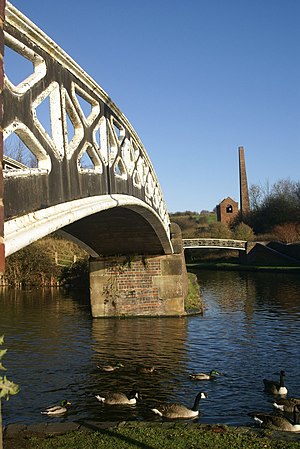
Following the Enclosure Acts of the late 18th century, allowing building in Pensnett Chase, the present town centre took shape further up the hill than its original site.[5] Netherton expanded rapidly in the industrial age and the thick seams of coal underlying the region were extensively mined. Blast furnaces were constructed in Netherton for steel making and the area became home to many industries including chain and anchor making, nail making, brick making, enamelling, and the construction of boilers.
In 1874, Dr. Ballard, sent by the Local Government Board to inspect the sanitary conditions of the Borough of Dudley, described Netherton as: 'a village of such size it almost deserves to be termed a town'.[6]
In the mid-19th century, the area was notorious for its bad sanitary conditions. In 1852 an inquiry into the sewerage, drainage and supply of water was carried out, reporting to the General Board of Health. Its conclusions were very damning for Netherton. A typical comment was: 'Old Netherton Town, Mr. Thomas Woodall's buildings.- Drainage very horrible, with privies and piggeries as usual, and no pavement. Procure water from a horse-pit nearly half a mile, and it has to be carried up hill, mostly by girls, in little pails of about three gallons, on their heads. This was a bad place for cholera'.[7]
In 1844, Netherton became an ecclesiastical parish.
The 20th century saw the gradual decline of mining and the heavily polluting industries such as iron-making. At the same time, Dudley Council sought to redevelop areas of Netherton for housing either by demolishing existing older housing (as occurred in areas adjacent to the Halesowen Road in the town centre) and rebuilding or by reclaiming abandoned industrial areas (for example in the Dudley Wood and Saltwells area to the south of the town).[8] Other former industrial sites were transfomed into parkland (Netherton Park) or nature reserves (e.g. Bumble Hole).
Some of the first council houses in the Dudley borough were constructed around Netherton Park in the early 1920s, around the same time as the Yew Tree Hills area, to rehouse families from older and dilapidated houses around Dudley and Netherton.
Churches and chapels
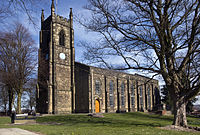
Netherton contains a number of churches and chapels. The most prominent, St Andrew's, the parish church.
St Andrew's was consecrated in 1830 and stands is situated on Netherton Hill at the highest point in the town. It was originally just a chapel-at-ease to St Thomas's of Dudley, only becoming Netherton's parish church in 1844.
Churches in Netherton include:
- Church of England:
- St Andrew's
- St Peter's, Darby End The Parish of St Peter
- St John the Evangelist, Dudley Wood St John the Evangelist]
Perhaps more characteristic of Netherton are the nonconformist chapels of which there are several.[9] In St Andrews Street, near the town centre, can be found the Ebenezer Baptist Church. In St Giles Street, the former Sweet Turf Baptist chapel has had its frontage altered and is now named the Champions Church. More evidence for Baptist activity in Netherton can be found on Cinder Bank where the burial ground for the Messiah Baptist church can be found (the church itself has been demolished). The Methodists have a church, The Trinity Methodist Church, on Church Road and another one, the Cole Street Methodist Church at Darby End. A former Methodist chapel, the Noah's Ark on Cradley road is presently (2008) being converted into apartments. On Chapel Street in the Primrose Hill locality one can find the Primrose Hill Congregational Church. The People's Mission have a chapel on Swan Street. The Champions Church have built a new church (opened January 2010) just off Cinder Bank near the junction with Simms Lane. In 1868 a Sunday School Union was arranged between several of the churches in Netherton and a hymn composed to commemorate the event was sung on Netherton market place.[2] The hymn mentions some of the above chapels. Part of it went:
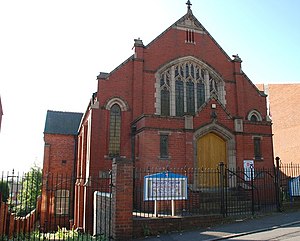
May Sweet Turf join with Cinder Bank,
And Ebenezer join the rank;
And may St. John's and Primrose Hill,
With Noah's Ark their stations fill.
And may Church Road, and Darby Hand,
All join in one harmonious band;
To spread the triumph of our King,
Who did for all salvation bring.
Notable buildings
Netherton's parish church, St Andrew's, consecrated in 1830, is situated on Netherton Hill at the highest point in Netherton. It was originally just a chapel-at-ease to St Thomas's of Dudley, only becoming Netherton's parish church in 1844.[10] The church is surrounded by the gravestones of many of the former residents of the area. The churchyard also contains the mass unmarked graves of the victims of cholera that struck Dudley in 1831 and 1832.[11]
Netherton's most notable public building is probably the Victorian era Netherton Arts Centre and Library at the top of Northfield Road. A fire station and a number of police houses were constructed at the same time on an adjacent site. These buildings are being transformed for commercial and community use.[12]
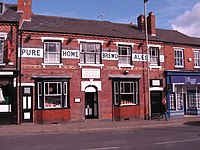
The Swan is a pub standing on the A459 Dudley-Halesowen Road. The current building dates from the 1860s but there has been a pub on the site since at least 1835.[13] It has been known as Ma Pardoe's since the interwar years, as its long-term landlady was Doris Clare Pardoe (born 1899) who owned it until her death in 1984, when she was 85 years old. Such was its fame among the lovers of real ale, that when the pub came up for sale in 1985, a company was set up by CAMRA to purchase and run the pub.[13] Although this company was short-lived, the pub and brewery survived and it is now one of only a handful of pubs in the Black Country which still brews beer on its own premises.[14] As well as for its beer, the pub is also known for its decor including a ceiling decorated with vitreous enamel tiles.[15] The pub has been designated a Grade II listed building.
Two old landmarks of Netherton can now be viewed only in the Black Country Living Museum. These include Harold Emile Doo's chemist shop[16] and Providence Church.[17]
Parks and recreation
Saltwells Nature Reserve stands on the Netherton - Brierley Hill border, next to Netherton Reservoir. It takes its name from Saltwells Wood, now just part of the reserve, named for its saline springs where people came to bathe in the 19th and early 20th centuries.[5] Doulton's Claypit, a Geological Site of Special Scientific Interest, lies within the reserve.[18]
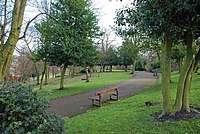
Netherton Park is found near the town centre and was laid out in about 1900 on an area that had once been colliery waste. Another old industrial area that has been reclaimed for public recreation is the Bumble Hole Local Nature Reserve.[19] This region lies to the east of the town.
The Dudley No. 2 canal runs through the reserve and is the site for an annual narrowboat festival. A canalside visitor centre provides information on the reserve and on the adjacent Warrens Hall Local Nature Reserve, which is in Sandwell. A rare Timber Gallows crane, a Scheduled Ancient Monument, stood in the reserve but is currently (2008) undergoing restoration.
Netherton Cricket Club was founded in 1866. Its ground is on Highbridge Road. The club celebrated its 140th anniversary in 2006.[20]
Netherton Reservoir stands approximately one mile to the south-west of the town centre, and is a popular resort for speedboat enthusiasts as well as scuba divers. Dudley Water Ski Club meet regularly at the reservoir.[21]
Transport links
The major road link for the town is the A459 running from Dudley to Halesowen, once a turnpike road with a toll gate near the junction with Swan Street.
The Dudley No. 2 Canal runs through Netherton, linking the Dudley No. 1 canal at Parkhead Junction with the south entrance of the Netherton Tunnel. When first constructed in 1798 it ran as far as Selly Oak where it connected with the Worcester and Birmingham Canal.
Netherton has had no rail service since the 1960s when the line, sometimes called the Bumble Hole Line, which linked the town with Dudley and Old Hill was taken out of service. The line had stops at Baptist End,[22] Windmill End and Darby End. A small branch line from Baptist End led to Withymoor Goods Station, which was near where the Dudley No. 2 canal crosses the Halesowen Road.
There were once many industrial and mineral rail lines running through the Netherton area but these have been long closed. For example, the steel firm Grazebrook's had a line running from their factory on Pear Tree Lane to an interchange on the Great Western Railway mainline near the former Blowers Green railway station to the south of Dudley. A branch of the Earl of Dudley's extensive private railway network, which is usually known as the Pensnett Railway, ran through the Saltwells locality.
Industry
Sited as it was on top of what was later called the South Staffordshire coal field with its numerous coal seams interspersed with layers of iron ore, fire clay and brick clay,[23] Netherton was probably always destined to become an area dominated by industry.
Mining
Mining in the Netherton area has taken place since at least the 14th century.[5] According to the Rent Rolls of Lord Dudley and Ward, the income from coal mining on Knowle Hill (the former name for Netherton Hill) formed a large fraction of the total income of the Dudley Estate in 1701.[24] In the 19th century, mining in the Netherton area was particularly extensive. Some of the collieries were: the Baptist End, Dudley Wood, Netherton, Netherton Old, Saltwell and Yew Tree Hill.[25] Coal mining was still being carried out in the 1970s when coal was removed from Netherton Hill by the open cast method.[5]
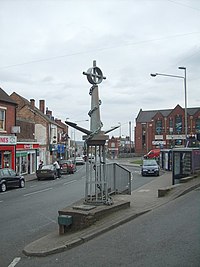
Nailmaking
Nailmaking in Netherton has been recorded since the 16th century.[2] Netherton became one of the centres in the Black Country of the hand-made nail trade which reached its peak around 1830.[26] As the hand-made nail trade went into decline, mainly due to the availability of cheaper machine-made nails, wages for nailmakers were decreased leading to industrial unrest such as the events known as the 'Blackcountry Nailer's Riots' of 1842,[27] and the Nailmakers' Strike of 1852.[2] The last type of nail to be made by hand were those used to shoe horses. The Midland Counties Express reported in 1904: 'a few horse-nailers at Netherton and about a dozen female workers at Cawney Hill are the only remaining representatives of the nail trade'.[26] Some nail-makers in the area turned to chain-making. A working chainshop is preserved in the Mushroom Green locality of Netherton.
Chain and anchor making
Once located in Netherton, was a firm of chainmakers called N. Hingley & Sons, which was famous for making the anchors for the Titanic ocean liner.[28] The works were set up by Noah Hingley in 1837 [29] on the banks of the Dudley No. 2 canal.[30] Anchor manufacture commenced in 1848 and the works were extended in 1852. The main anchor for the Titanic weighed fifteen and a half tons and, on completion, was hauled from the factory to the rail head at Dudley Port by 20 shire horses.[31] Hingleys also produced anchors for the Lusitania and a number of other ocean liners, most of which were more fortunate in their voyages than the Titanic and Lusitania'.[30] Hingleys' success in international markets and their use of the Netherton name for their trademarked wrought iron products (for example Netherton Crown Special Best Best Iron) caused the name of Netherton to be known more widely both in the British Empire and in foreign lands.[30] A sculpture of an anchor stands at the junction of Castleton Street and Halesowen Road commemorating the local anchor and chain industry[32] and the anchor motif can be found in a number of places around Netherton (for example on the metal park benches in Netherton Park).
Immediately adjacent to the works of N. Hingley & Sons on the Dudley No. 2 canal was Lloyds Proving House where chain was subjected to a variety of tests to show it was of suitable quality.[33]
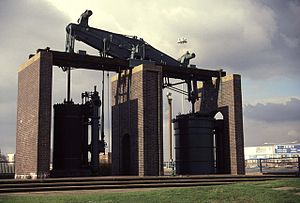
Brewing
Brewing was a major industry in 19th century Netherton.[34] Some of the large scale brewers were: William Hotchkiss at Castle Street, William Smith at Simms Lane, John Rollinson of St Andrew's Street, and Samuel Bagley at Cole Street. The largest brewery belonged to Thomas Plant and was known as the Netherton Steam Brewery. Plant's malthouse was on Raybould's Fold and the brewery in St John's Street. The only brewing today in Netherton takes place at the Old Swan pub mentioned in 'Notable Buildings' above.
However, two of the remaining Black Country brewers, namely, Holdens and Bathams have Netherton links.[35] Edwin Alfred Holden and Lucy Blanche Holden, founders of the Holdens brewing concern, had their first pub in Netherton, whilst Daniel Batham, son of Daniel and Charlotte Batham who had started the family beer production, brewed at the King William in Cole Street, Netherton before moving the brewery to its present location at the Vine on the Delph.[36]
Other industries
One of the earliest manufacturing firms established in Netherton was Samuel Lewis & Co Ltd which was set up in 1750.[2] Other notable firms were: Danks, which made boilers; John Barnsley and Co., specialists in cranes and hoists; and Grazebrook's, which had furnaces for iron-making.[10] The latter firm was established at Netherton in 1800 by Michael Grazebrook.[3]
Industry today
Although not of the scale of previous times, industrial firms can still be found in Netherton; for example, in the Washington Centre between the Halesowen Road and Cradley Road or in the Blackbrook Business Park, Narrowboat Way, the latter of which was developed in the 1980s as part of the Dudley Enterprise Zone that stretched beyond Netherton's borders into Brierley Hill and covered the land which became the Merry Hill Shopping Centre.
Outside links
- Netherton – Pictures as teachers' resources
References
- ↑ "Historic Environment SPD Appendix Part One". Dudley Metropolitan Borough Council. 2006-09. http://www.dudley.gov.uk/EasysiteWeb/getresource.axd?AssetID=2949&type=full&servicetype=Attachment. Retrieved 2012-02-08.
- ↑ 2.0 2.1 2.2 2.3 2.4 2.5 2.6 Fletcher, M.H.W. (1969). NETHERTON: Edward I to Edward VIII. Dudley Public Libraries, County Borough of Dudley. ISBN 0-900911-05-0.
- ↑ 3.0 3.1 3.2 Chandler, G. and Hannah, I.C., Dudley: As it was and as it is to-day, B.T.Batsford Ltd., London, 1949
- ↑ A History of the County of Worcester: Vol. 3
- ↑ 5.0 5.1 5.2 5.3 "History of Saltwells Local Nature Reserve". Dudley Metropolitan Borough Council. 2005-04-26. http://www.dudley.gov.uk/environment--planning/countryside/nature-reserves/saltwells-local-nature-reserve-/history-of-saltwells-local-nature-reserve. Retrieved 2007-03-03.
- ↑ Ballard,Dr, Report to the Local Government Board on the sanitary condition of the Municipal Borough of Dudley, 1874.
- ↑ Lee, William, Report to the General Board of Health on a preliminary inquiry into the sewerage, drainage and supply of water, and the sanitary condition of the inhabitants of the Parish of Dudley in the county of Worcester, London, 1852.
- ↑ The University of Liverpool (1951). Social Aspects of a Town Development Plan. The University Press of Liverpool.
- ↑ Williams, N. (2004). Black Country Chapels. Sutton Publishing. ISBN 0-7509-3990-7.
- ↑ 10.0 10.1 Williams, N. (2006). Netherton. Sutton Publishing. ISBN 0-7509-4182-0.
- ↑ Clarke, C.F.G. (1881). The Curiosities of Dudley and the Black Country. Birmingham: Buckler Brothers.
- ↑ Dudley Metropolitan Borough Council: Community celebrates opening with 'Tea at The Savoy'
- ↑ 13.0 13.1 Richards, John (1989). The Pubs & Breweries of Old Dudley Borough. Real Ale Books. ISBN 0-9514640-0-0.
- ↑ "Eating and drinking". Dudley Metropolitan Borough Council. 2005-06-13. http://www.dudley.gov.uk/leisure-and-culture/tourism-travel/out-and-about/eating-and-drinking. Retrieved 2007-03-03.
- ↑ "IVE Gallery: Ma Pardoe's". The Institute of Vitreous Enamellers. 2008-05-19. http://www.ive.org.uk/gallery/ma-pardoes.html. Retrieved 2008-11-26.
- ↑ "The Chemist". Black Country Living Museum. http://www.bclm.co.uk/map23.htm. Retrieved 2007-05-24.
- ↑ "Chapel". Black Country Living Museum. http://www.bclm.co.uk/map24.htm. Retrieved 2007-05-24.
- ↑ "The Changing Relationship Between Cities and Biosphere Reserves". UK-MAB Urban Forum. Archived from the original on 2007-10-11. http://web.archive.org/web/20071011144713/http://www.ukmaburbanforum.org.uk/Publications/Cities_rep/cities5.htm. Retrieved 2007-06-28.
- ↑ "Bumble Hole and Warrens Hall Local Nature Reserves". Dudley Metropolitan Borough Council. http://www.dudley.gov.uk/leisure-and-culture/parks-and-open-spaces/liveability/bumble-hole-and-warrens-hall-local-nature-res. Retrieved 2007-04-05.
- ↑ "Netherton Cricket Club". http://netherton.play-cricket.com/home/home.asp. Retrieved 2007-08-01.
- ↑ Dudley Water Ski Club
- ↑ "Baptist End Halt". Rail Around Birmingham and the West Midlands. http://railaroundbirmingham.co.uk/Stations/baptist_end_halt.php. Retrieved 2007-05-19.
- ↑ Raybould, T.J. (1973). The Economic Emergence of the Black Country. David & Charles. ISBN 0-7153-5995-9.
- ↑ Court, W.H.B. (1953). The Rise of the Midland Industries 1600-1838. Oxford University Press.
- ↑ "Worcestershire's Mining Industry in 1896 - A List of Coal Mines". http://www.pdmhs.com/1896%20Lists/1896-B4.htm. Retrieved 2008-10-15.
- ↑ 26.0 26.1 Henn, K (1928). The Hand-made Nail Trade of Dudley and District. reprinted from the Dudley Herald.
- ↑ Willetts, Arthur (1995). The Blackcountry Nailer's Riots of 1842. Dudley Libraries. ISBN 0-900911-36-0.
- ↑ "Dudley". Black Country Chamber. Archived from the original on 2006-10-05. http://web.archive.org/web/20061005074135/http://www.blackcountrychamber.co.uk/desktopdefault.aspx?tabIndex=0&tabId=1371. Retrieved 2007-03-03.
- ↑ "N. Hingley & Sons Ltd, Washington Street, Netherton". http://blackcountryhistory.org/collections/getrecord/GB145_p_430/. Retrieved 2012-02-08.
- ↑ 30.0 30.1 30.2 Mallin, K (1998). Noah Hingley. published privately. ISBN 0-9510420-3-3.
- ↑ "Photographs from the past". Dudley Metropolitan Borough Council. http://www.dudley.gov.uk/leisure-and-culture/local-history--heritage/archive-and-local-history/photographs-from-the-past. Retrieved 2008-06-19.
- ↑ "Public Monument and Sculpture Association". http://pmsa.cch.kcl.ac.uk/BM/WMduNEjj002.htm. Retrieved 2007-05-02.
- ↑ Moss, Ron (2006). Chain & Anchor Making in the Black Country. Sutton Publishing Ltd. ISBN 0-7509-4221-5.
- ↑ Stevens, Geoff (1972). The Brewer's Swan Sung, in The Blackcountryman Vol.5 No.4. Black Country Society.
- ↑ Crawford, Alan (1986). Birmingham Pubs 1880-1939. Alan Sutton Publishing. ISBN 0-86299-221-4.
- ↑ "Staffordshire Breweries". http://www.midlandspubs.co.uk/breweries/staffordshire.htm. Retrieved 2011-05-17.